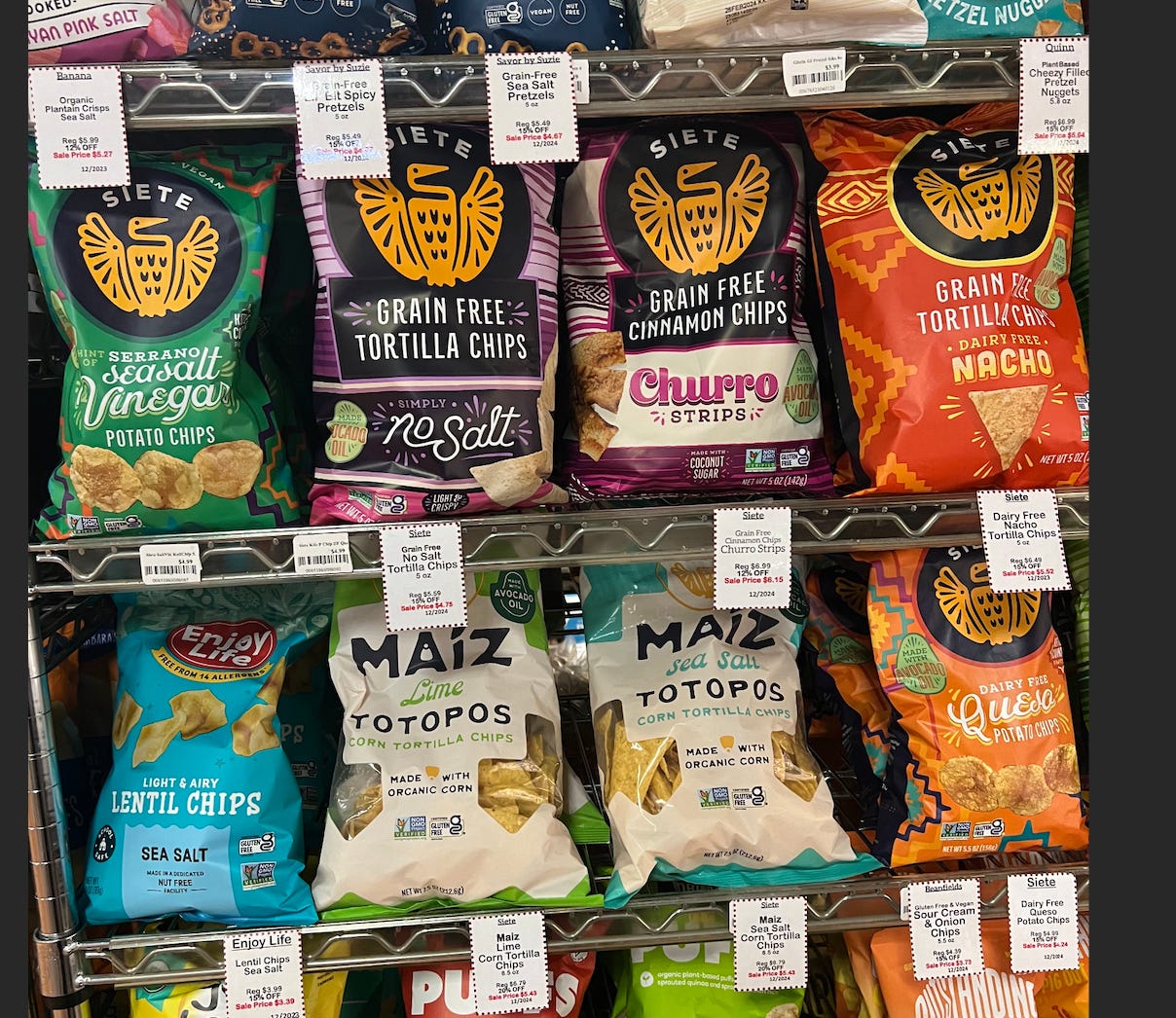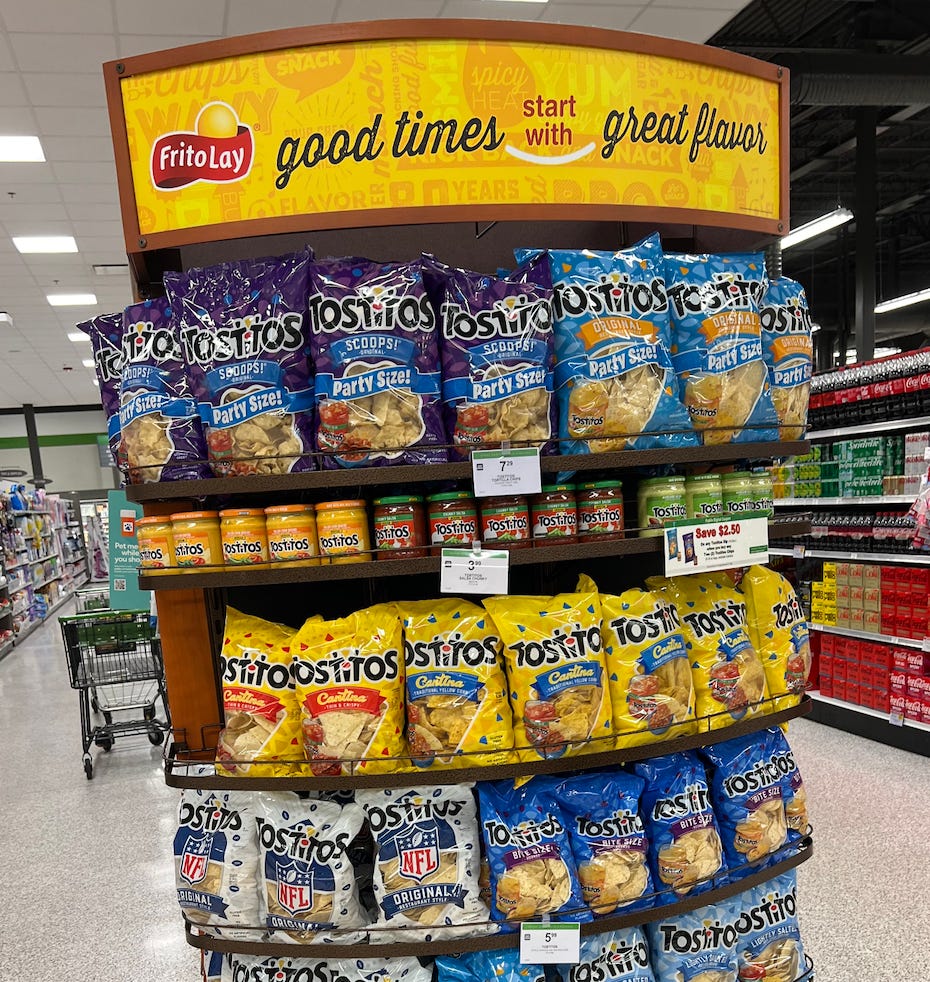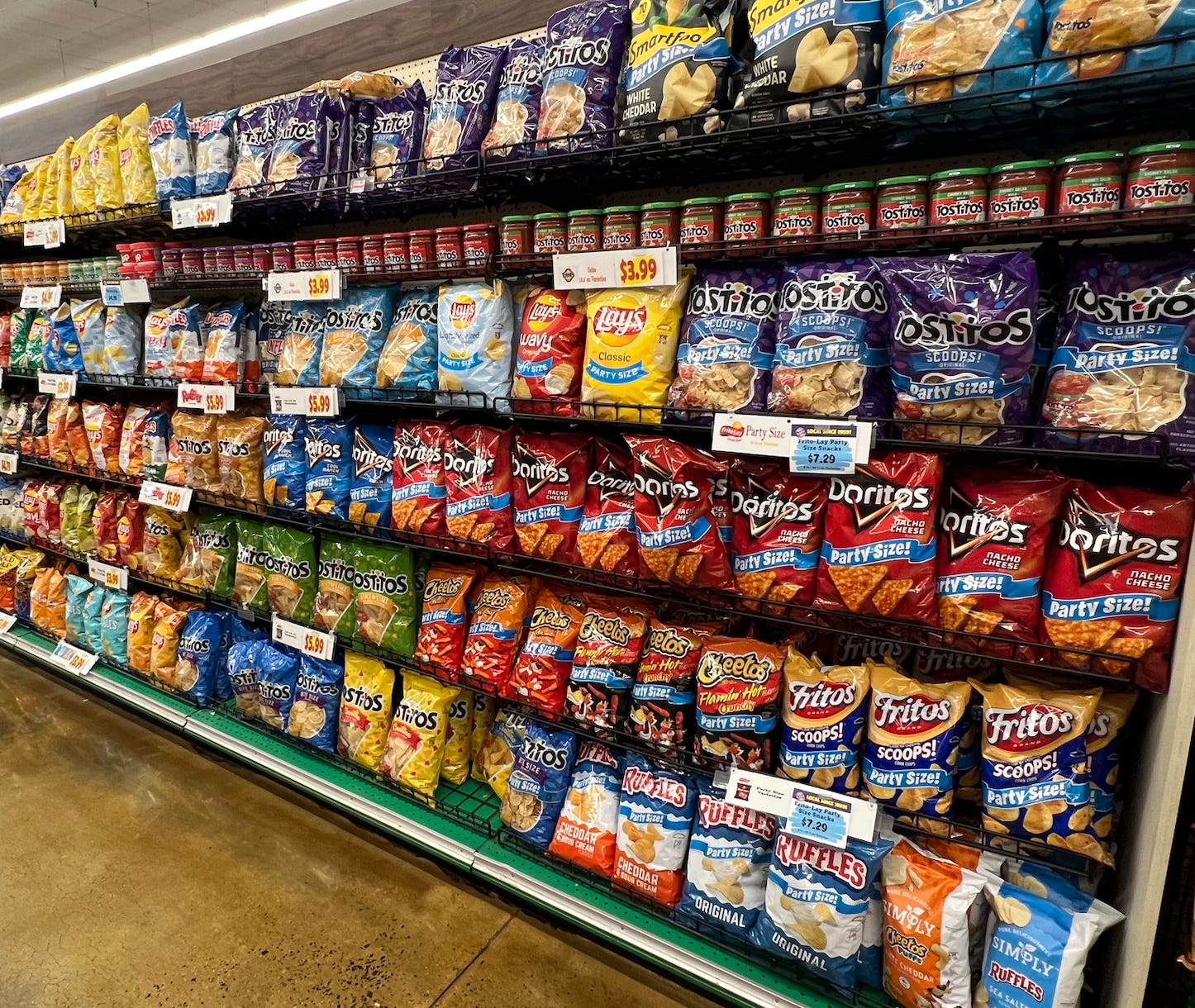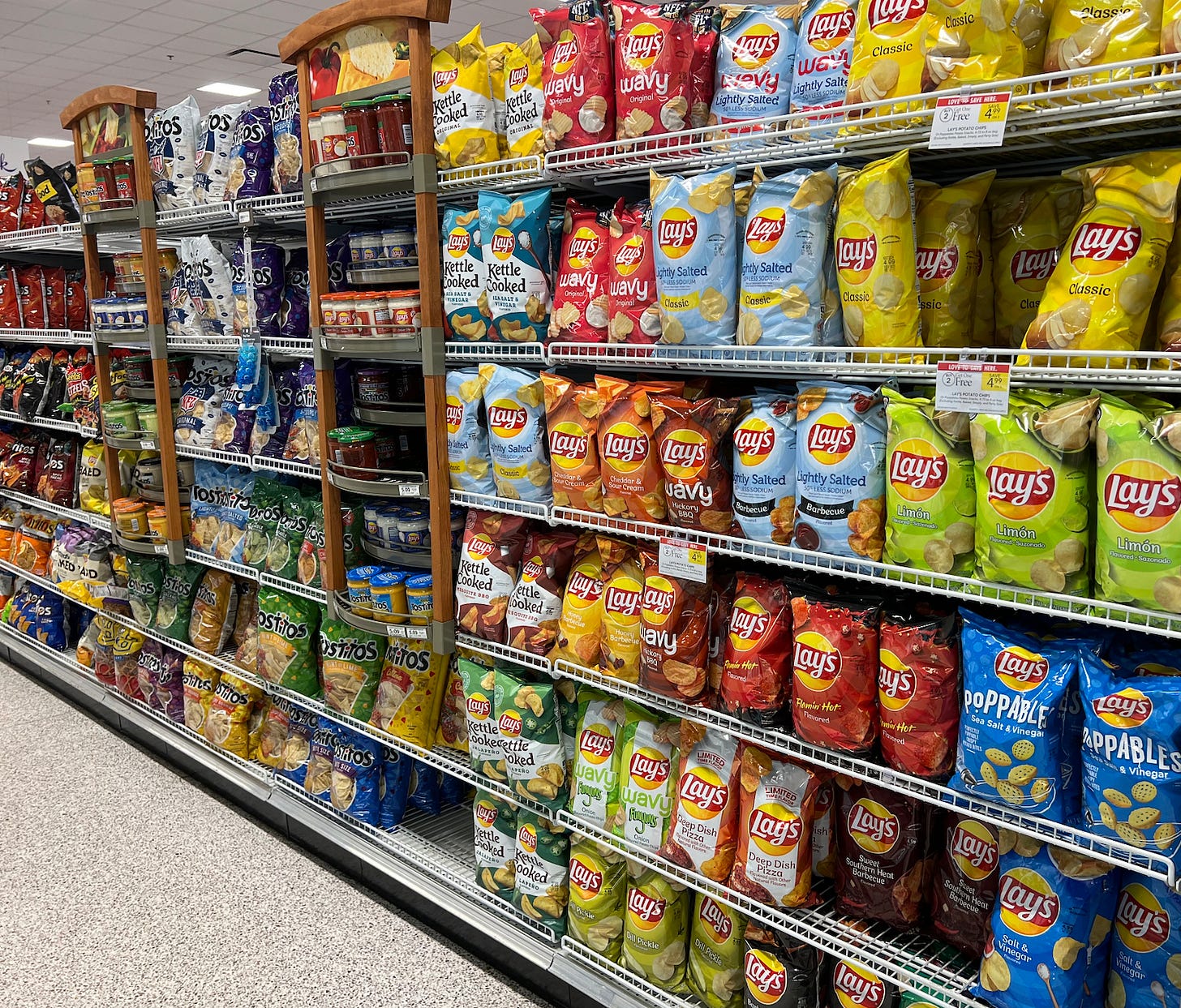Discontents: 1. News and Stuff. 2. Helene Disaster Aid. 3. USDA Funds Spying On Food Activists. 4. WHYY Radio Spot: Why Groceries Are So Expensive. 5. Main Feature: When Pepsi Met Siete. 6. A Regenerative CPG Dialogue For Retailers. 7. Tunes.
1. News and Stuff:
Stay tuned for an announcement on an upcoming Grocery Update A.M.A. (A.K.A. Ask Me Anything). Topics will be grocery industry trends and really anything we cover in this newsletter. We will schedule and record it on Zoom for Paid Subscribers and Founding Members to attend (or view afterwards). Coming Soon!
2. Helene Disaster Aid.
Communities across Appalachia, including grocery retailers, manufacturers, growers, their employees and their families, have been terribly impacted by Hurricane Helene. There is no high ground to run to when it comes to these climate-related disasters. At some point, we are all downstream. Here is a list of resources to support and share.
3. USDA Undermining Critics of Big Food.
The USDA is funding a creepy social network founded by an ex-Monsanto flack that spies on and attacks critics of industrial agriculture, like Nnimo Bassey, Vandana Shiva, Michael Pollan and Mark Bittman. So gross.
4. WHYY: Why Are Groceries Still So Expensive.
ICYMI. I did a live spot on WHYY, a Philadelphia-based NPR affiliate to clear the air on why groceries are so damn expensive. Link here: https://whyy.org/episodes/why-are-groceries-still-so-expensive/
Main Feature:
5. When Pepsi Met Siete.
“Consolidation and market dominance ensure these big CPG’s will be just fine in the long run. They may switch up their portfolios with more nutrient dense, organic, non-GMO, lower fat, lower sugar, higher fiber, lower carb or satiety-inducing options. Or they will go on a shopping spree for acquisitions plucked from the throngs of cash-starved, high growth, “better for you (BFY)” emerging brands… “BFY” products have outperformed the rest of the market by almost 10 percentage points in the last 3 years. They are close to $80 billion in annual sales, or nearly 8% of the total grocery industry… Emerging CPG brands like Siete Foods, Simple Mills and Partake Foods have “de-junkified” familiar products… Study after study shows that consumers, especially the younger folks grabbing ever greater market share, strongly prefer “better for you” products…”
-I wrote this in Forbes in March 2024, “Why We Need to Reinvent Food Processing”.
Pepsico has announced plans to acquire next gen snack food maker Siete Foods for $1.2 billion. The 10 year old Austin, Texas based company had over $400 million in annual retail sales in 2023. The brand was launched nationally by my team at Whole Foods in 2016 after being discovered by the buyers at the local Wheatsville Food Co-op. In 2019, Siete closed a $90 million minority stake investment from Stripes Group off of a reputedly $500 million valuation.
As a brand, Siete Foods makes great products that are high quality, innovative in the fullest sense of the word and trend leading, from cassava-based tortillas, chips and cookies, to avocado oil potato chips and authentic maiz-based tortilla chips. The products are authentic and creative, and deeply influenced by their family heritage of the Rio Grande Valley, featuring eye catching, meaningful design work.
Siete Foods is a ubiquitous market leader on special diet packaged food segments, including paleo-adjacent, plant-based, gluten free, non-GMO and/or organic, seed oil free and anti-inflammatory consumer attributes. They have been a huge category growth engine for snacks in natural and specialty grocers, especially Whole Foods. But with distribution in 40,000 other stores, they are also a key innovator at cooperatives, Kroger and Albertsons banners, and independents across the country. They have been spending lavishly on promotions to juice their sales numbers, coasting on investment dollars via high customer retention and repeat purchase rates. They have also been a leader in what I refer to as “hyper-premiumization”, higher prices per ounce for targeted, specialized, high attribute products for key customer demographics. Simple Mills and Partake Foods are similar in this regard. (Hyper-premiumization? I would define this as “This shit ain’t cheap, but if it’s what you need, it’s worth it.”)
The Siete Acquisition.
The deal comes on the heels of the controversial $36 billion Mars-Kellanova merger and General Mills selling off Yoplait for $2.1 billion to Lactalis, concentrating 75% of yogurt sales into just 3 companies. Pepsico is one of the largest food and beverage companies in the world, with over $90 billion in annual sales. Their eponymous beverage division makes and distributes soft drinks like Pepsi and Mountain Dew, leading sports drink Gatorade and re-branded municipal tap water Aquafina. They own Quaker Oats and several other pantry brands, as well as a number of snack and beverage companies in Africa, the Middle East, Europe and Latin America.
Over 59% of Pepsico’s sales are in packaged food. Around 46% of Pepsico revenue is from its massive Frito Lay snacking division, maker of Fritos, Doritos, Cheetos, Tostitos, Lays, Smartfood, Cracker Jack, Sun Chips, Ruffles, Rold Gold and more. In past years they also acquired natural snack brands Stacy’s, Popcorners and Bare Snacks. Their in-house DSD network (direct service distribution, meaning they own, order, stock and merchandise their products in retail stores) enables Pepsico to control 50+% snack aisle market share in many metro areas. They also sell products to retailers through third party distributors such as UNFI. While Pepsi may square off with Coca-Cola for soda duopoly domination, in the snack aisles they are an actual, true to life food monopoly, the elephant in the grocery living room, King Fucking Kong. The biggest of Big CPG. Big Food.
The other big winner in the deal will be consumers via the expanded distribution of Siete products, especially through the Frito Lay DSD network. This could mean placement at every Walmart, dollar store, gas station, bodega, convenience store, and Mom and Pop indie grocer that has a Frito Lay truck stopping at its door. In the corporatized, for-profit, privately-owned food supply chain, such market expansion is the only way that the majority of people get access to a wider variety of the shelf stable, processed food options that make up the vast majority of calories consumed by poor and working class Americans. Denying such expansion just enables elitism and food apartheid. Obviously, there are better ways to bring good food to the people, but until a new supply chain paradigm becomes the status quo, this is our reality.
Pepsico will also fold Siete production into their huge, highly competent manufacturing network to find ingredient procurement, processing and logistics efficiencies. Pepsico may rationalize or look for cheaper alternatives for some ingredients, but they are not dumb, they won’t visibly or sensorally alter formulations to the point of alienating core customers. Stacy’s is still Stacy’s. It is not special or high touch. It is highly commoditized, consistent, homogenized and the same wherever you buy pita chips, if you like pita chips. A miracle of modern food science and food processing. Pepsico will slowly graduate the products down to their lowest common denominators to retain loyalists but broaden the appeal, maximizing distribution while managing gross margins.
They will have minimal new item innovation once Pepsico R&D gets involved, unless Siete co-founder and brilliant brand formulation lead Veronica Garza is kept on retainer to guide their thought process. Pepsico does not innovate. They do line extensions, variations on themes. Cool Ranch everything. Hotter Cheetos. Taco Bell mashups. Brute force taste and sensory microtargeting and habit formation. Phillip Morris on MSG. They are all about conquest and domination, scaling up to own categories with their core assortment. Why take unnecessary risks when you own the shelf space and the trucks and labor to stock it? Maybe Siete’s attributes will have some influence on the Frito product portfolio. Non-GMO, grain-free Doritos or other cassava based Frito snacks. Less MSG, more actual seasonings. But Siete is now and forever a snack brand. While they may continue to dabble in adjacent categories, the Pepsico money, the real money, is in mass market snacks.
The deal may also enable Pepsico to appease the mildest critics of their business model by showing they are responding to market pressures and consumer trends. They are betting on a younger, more diverse, more health and sustainability focused customer cohort, not just your workaday Doritos muncher (no offense intended here, that was how I grew up too.)
But moreso than any other Big CPG, Pepsico is ground zero for Big Food Problems. They are being sued for plastic pollution in oceans and waterways. Their business model is wholly based on ultra processed foods, and their inherent health, social and environmental externalities. Pepsi has been a leader in the root causes of inflation, taking higher prices quarter after quarter while selling less actual products, colloquially knows as price gouging, popularizing price over volume strategies like “shrinkflation”, leading to profit taking at an absurd scale. Why do your soda and chips cost 40-50% more than a few years ago? Record pandemic profits.
Pepsico’s health externalities are not trivial. U.S. healthcare costs from diet related illnesses and “noncommunicable diseases” top $1.3 trillion a year, over a thousand times the value of the Siete deal and more than 30% higher than the annual sales of the entire grocery industry. Pepsico is fully invested in UPFs down to the seed and soil level, with both snack and beverage businesses built on an ocean of federally subsidized, genetically modified corn doused in glyphosate, or engineered with pesticides in their genomes, milled and processed into high fructose syrup, corn flour or a thousand other fillers, byproducts, sweeteners, additives, emulsifiers and assorted gunk. Pepsico is also Big Corn, harvesting across millions of acres of monocultured farmland.
Pepsico is also the master of monopolizing shelf space and leveraging the most blatant practices of the consumer packaged grocery sector, including deep pocketed trade and promotional spend for sales, displays and BOGOs, paying retailers slotting fees that guarantee favorable shelf placement, funding category captain arrangements where their data and analytics teams advise grocers on what to do across the total snack category and investing in full integration of omnichannel distribution, online fulfillment and the growing web of retail media networks.
Pepsico Is Very Smart.
They have seen the writing on the wall, reading their own (Lipton) tea leaves about Ozempic, blood glucose, weight management and lower glycemic food trends. Siete is the perfect solution to this. It is both incremental and fits hand in glove within their product portfolio, their supply chains and their business model. With presidential candidates pointing fingers about corporate price gouging driving inflation, even congressional Republicans waking up to the externalized costs of processed foods, and with an activated Federal Trade Commission amidst a wildly popular, bipartisan concern about market concentration and monopolies across all levels of the food supply, buying Siete is a nimble pivot that gives Pepsico ample public relations cover while changing absolutely nothing about how they make their money.
And this is also the smart money. Pepsico ROI on the $1.2B price tags will be in distribution gains, reducing overhead costs through absorbing staff into their sales, operations, marketing and manufacturing organizations, lowered ingredient costs through supply chain and logistics efficiencies and folding sky high trade spend into their enterprise wide trade and marketing strategies. Sure, they will keep their UNFI and KeHe deals going, they know how to keep the category buyers in Providence and Austin and Boise happy. But they will start counting those pennies much more carefully. And while it will be business as usual for grocers for the time being, over the medium term indie and natural grocers will get pressured on pricing as distribution in mass and conventional channels scales up. The acquisition also gives Pepisco a nice leg up on Snyder’s, their biggest DSD snack competitor and maker of Snyder’s Pretzels, Kettle Chips, Pretzel Crisps, Pepperidge Farm, Late July, Cape Cod and other snack aisle rivals, now wholly owned by Campbell’s. Likewise for Hershey’s/Amplify Snacks. Snack wars are always so fun.
And this is probably the biggest monopoly acquisition of an upstart, innovative specialty food brand since Amazon devoured Whole Foods around 2017. That one has been, at best, a mixed bag. Prices have come down, the retailer does some cool stuff with regenerative products and sustainability, but employees are more expendable, the stores aren’t run as well and they can’t seem to stay in stock. Like in 2017, there is now breathless excitement, irrational LinkedIn hot takes and an exaggerated sense of optimism and possibility, all for Pepsi buying Siete. Sure, it is great news for the Garza family, groundbreaking innovators who built a business around their food sensitivities, cultural heritage and sincere impetus to create better options. They deserve the win. They should take the money and never look back. Their other options could have been getting in bed with more private equity dude-bros or continuing to slug it out as a scrappy independent operator, which is not a great lifestyle choice at the scale they were growing. Hopefully, the cash means they will spread the love and invest in, mentor up and seed many other diverse owned good food enterprises and organizations. Or enjoy life and do other good things with their hard earned cash.
But it doesn’t mean their big win can happen to just anyone.
Siete Foods Is A Unicorn.
In the fullest sense of the finance/tech sector concept. There are very few other next generation CPG brands out there with their proven road worthiness and future potential for growth, their customer loyalty, their brilliant execution of who they are marketing to and what they want to eat, connecting the dots between consumer trends and diverse, younger cohorts that are still the focus of every Bain, McKinsey and BCG white paper this side of Park Ave and 54th street. They are THE case study.
Yes, it signals that Big CPG is willing to pay top dollars for leading “BFY” brands. As interest rates come down, expect more medium scale M&A activity to pick up. Investment in CPG innovation has plummeted by over 80% in the fast few years. Meanwhile, private equity is sitting on record levels of “dry powder” accumulating massive capital on compound interest every minute of the day. They have money to burn, but they just can’t seem to deploy.
Who knows, maybe the Siete Foods deal will expand financing and shelf placement options for more diverse, millennial and Gen Z owned consumer brands who are authentically fulfilling such consumer need states. $1.2 billion is a healthy market validator. Crazier things have happened.
But in the most contradictory American fashion, in the prototypical food industry dialectic, where a handful of companies control vast swathes of grocery shelves, PepsiCo’s Siete deal will enable millions of new consumers to enjoy higher quality, higher attribute plant-based packaged foods that likely have fewer health and environmental externalities as incumbent Pepsico products. And it will also further entrench monopoly power and market concentration. It will give Big Food deeper reach and insights into growing consumer cohorts, dietary trends and wellness need states without any fundamental changes to the damage they are causing in society.
And so Big Food wins again. We can snack on that.
6. Kyle Koehler: A Dialogue On Regenerative CPG.
Kyle Koehler is the CEO and Founder of Wildway, a breakfast and snack food company based in San Antonio, Texas whose products benefit ecosystems, communities, and the environment through regenerative practices that create positive health impacts for people and the planet. They focus on using regenerative, organically grown, and biodiverse ingredients in order to increase demand for regeneratively farmed crops and are working to build a product portfolio around underutilized regeneratively grown ingredients supplied by smallholder farmers.
This dialogue was reprinted from Kyle’s LinkedIn post, which I thought was cool. Retailer friends, talking to you here.
Retailer: We’re prioritizing regenerative organic products in our stores and on our shelves. We want products beneficial to planetary health and human health.
Kyle Koehler: I love that. I have some wonderful products I have been working on. These farmers are doing some amazing work to help build soil health and ecosystem biodiversity.
Retailer: That's great. So what does it cost?
Kyle Koehler: Well, the additional labor and farming practices on the farm do add cost to most of these ingredients. On the manufacturing side… we pay employees a living wage, which we think is incredibly important, but it does also add some cost to the final product. Since you are supporting planetary health and human health I know you will understand the cost implications, so here is what that looks like.
Retailer: I need it cheaper.
Kyle Koehler: OK. There are many ways we can partner together to make better food more affordable:
1) You could give me an upfront commitment to a certain number of stores and a commitment to at least 18+ months on shelf to help reduce my risk and help ensure that I can generate a positive return. This would allow me to reduce my cost some.
2) You can help me circumnavigate financially extractive distribution partners so I don't have to build those costs into my product cost. These have become a significant cost addition that is built into product cost.
3) You can agree to give me preferential store placements (side caps, end caps etc) for reduced cost to help reduce my trade spend and the amount that is built into product cost and overall margin.
4) You can waive some of the upfront fees (free fills/slotting) so that I don't have to build those into product and supply chain costs.
5) We can get really creative and you can help fund some of the ingredient purchases or manufacturing in exchange for a reduced shelf price as I could significantly reduce the margin on my side. All in all, we could ideally partner together to reduce the final price of my product on shelf by 20-30%, and create a win for your customers, you, us, and our farming partners.
Retailer: I need it cheaper…
7. Tunes
The greatest mention of a Pepsi in any song, ever. Via L.A.s’ finest.
peace.







The Siete take is on point, thanks so much!
Really excellent column.